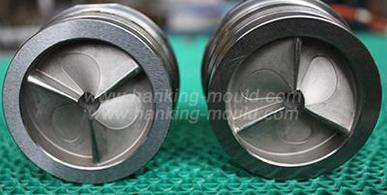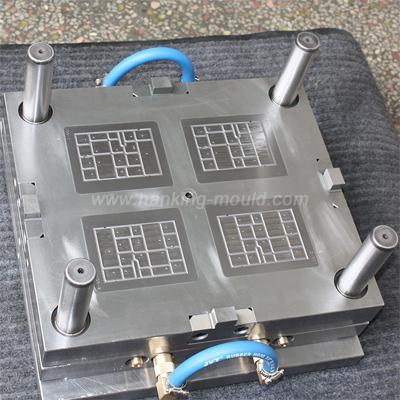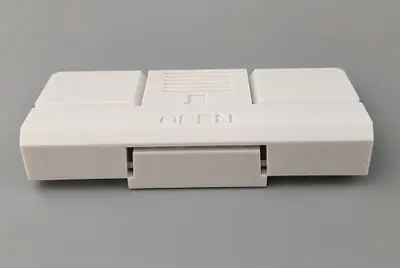

First, let's take a look at what effects mold temperature has on injection molded products.
First of all, the mold temperature is too low, it will reduce the melt flow, and may occur under-injection; mold temperature affects the plastic crystallinity, for ABS, the mold temperature is too low, the product finish is low. Compared with the filler, the plastic is more likely to migrate to the surface when the temperature is high. Therefore, when the temperature of the injection mold is high, the plastic component will be closer to the surface of the injection mold, and the filling will be better, and the brightness and luster will be higher. However, the temperature of the injection mold should not be too high, too high is easy to stick to the mold, but also in the plastic parts of local places appear obvious bright spots. If the temperature of the injection mold is too low, it will cause the plastic part to be too tight, and it will be easy to pull the plastic part, especially the pattern on the surface of the plastic part, when it is demolded.
Multi-stage injection molding can solve the problem of location, such as the product into the glue when there are air lines can take the way of segment injection. In the injection molding industry, the higher the temperature of the mold, the higher the gloss of the product surface, and the opposite temperature is low, the gloss of the surface is also relatively low. However, for the products of sunburst PP material, the higher the temperature, the lower the gloss of the product surface, the lower the gloss, the higher the color difference, the luster and color difference are inversely proportional.
Therefore, the most common problem caused by mold temperature is the rough surface finish of molded parts, which is usually caused by low mold surface temperature.
Molding shrinkage and post-molding shrinkage of semi-crystalline polymers depends mainly on the temperature of the mold and the part wall thickness. Uneven temperature distribution in the mold will result in varying shrinkage, thus making it impossible to ensure that the part meets the specified tolerances. The worst case scenario is that the shrinkage exceeds the correctable value regardless of whether unreinforced or reinforced resins are processed.
Mold temperature is too high, it will make the melt thermal decomposition, the products out after the shrinkage in the air increased, the product size will become smaller, mold in low temperature use conditions, if the size of the parts become larger, generally due to the mold surface temperature is too low caused. This is because the mold surface temperature is too low, then the product in the air shrinkage is also lower, so the size is larger! The reason is: low mold temperature makes the molecules "freeze orientation" faster, making the melt in the cavity of the freezing layer thickness increased, while the mold temperature is low to prevent the growth of crystallization, thus reducing the molding shrinkage of the product. Conversely, high mold temperature results in slow cooling of the melt, long relaxation time, low orientation level, and favorable crystallization, resulting in a larger actual shrinkage of the product.
If the start-up process is too long before the dimensions stabilize, this indicates poor mold temperature control, which is due to the fact that the mold takes longer to reach thermal equilibrium.
Uneven heat dispersion in certain parts of the mold can lead to significantly longer production cycles and thus higher molding costs! Constant mold temperature reduces the fluctuation of molding shrinkage and improves dimensional stability. Crystalline plastics, high mold temperature is conducive to the crystallization process, and fully crystallized plastic parts will not change in size during storage or use; however, high crystallinity shrinkage is large. For softer plastics, low mold temperature is appropriate in molding, which is beneficial to dimensional stability. For any kind of material, constant mold temperature and consistent shrinkage are good for improving dimensional accuracy!
If the cooling system of the mold is not designed properly or the mold temperature is not controlled properly and the plastic parts are not cooled enough, it will cause warping and deformation of the plastic parts. For mold temperature control, according to the structural characteristics of the product to determine the temperature difference between the front and rear mold, mold core and mold wall, mold wall and insert, so as to use the different cooling and shrinkage speed of each part of the control mold, the plastic part tends to bend to the higher temperature side of the traction direction after demolding, to offset the orientation shrinkage difference and avoid warping and deformation of the plastic part according to the orientation law.
For the plastic part with completely symmetrical shape structure, the mold temperature should be maintained accordingly, so that the cooling of each part of the plastic part is balanced. Stable mold temperature and balanced cooling can reduce the deformation of plastic parts. If the temperature difference of the mold is too large, the cooling of the plastic part will be uneven and the shrinkage will be inconsistent, which will cause the warping and deformation of the plastic part, especially for the plastic part with uneven wall thickness and complex shape. The side of the mold temperature is high, after the product cools, the deformation direction must be to the side of the mold temperature deformation! It is recommended that the front and rear mold temperature be chosen reasonably according to the need.
If the mold temperature is too low, the melt marks of plastic parts are obvious, which reduces the strength of products; for crystalline plastics, the higher the crystallinity, the greater the tendency of stress cracking of plastic parts; in order to reduce stress, the mold temperature should not be too high (PP, PE). For PC, a non-crystalline plastic with high viscosity, its stress cracking is related to the size of the internal stress of the plastic part, and increasing the mold temperature is conducive to reducing the internal stress and reducing the tendency of stress cracking.
The internal stress is expressed as stress marks obviously! The reason is: the formation of internal stress in molding is basically caused by the different thermal contraction rate during cooling, when the product is molded, its cooling is gradually extended from the surface to the inside, the surface first shrinks and hardens, then gradually to the inside, in this process due to the difference between the speed of shrinkage and internal stress. When the residual internal stress inside the plastic part is higher than the elastic limit of the resin, or under the erosion of certain chemical environment, the surface of the plastic part will be cracked. Studies on PC and PMMA transparent resins show that the residual internal stresses are compressive in the surface layer and tensile in the inner layer.
The surface compressive stress depends on the cooling condition of the surface. A cold mold causes the molten resin to cool down rapidly, which results in a high residual internal stress in the molded part. The mold temperature is the most basic condition to control the internal stress, and a slight change of mold temperature will have a great change on its residual internal stress. Generally speaking, each product and resin has its own minimum mold temperature limit for acceptable internal stress. And when molding thin wall or longer flow distance, the injection mold should be higher than the minimum limit in general molding.
Especially for crystalline plastics, if the product is molded at a lower mold temperature, the molecular orientation and crystallization are instantly frozen, and when a higher temperature use environment or secondary processing conditions, its molecular chains will undergo a partial rearrangement and crystallization process, making the product deform at even much lower than the material's heat deflection temperature (HDT).
The correct approach is to use the recommended mold temperature close to its crystallization temperature, so that the product can be fully crystallized during the injection molding stage and avoid such post-crystallization and post-shrinkage in high temperature environment. In conclusion, mold temperature is one of the most basic control parameters in the injection molding process, and it is also the primary consideration in mold design.
How to set the mold temperature reasonably
Nowadays, molds have become more and more complex, therefore, it becomes more and more difficult to create suitable conditions to effectively control the molding temperature. With the exception of simple parts, a mold temperature control system will usually be a compromise. Therefore, the following recommendations are only a general guide.
Temperature control of the part form being processed must be considered during the mold design phase.
If designing a low injection volume, large mold size mold, it is important to consider good heat transfer.
Make allowances when designing the cross-sectional dimensions of the fluid flow through the mold and feed tube. Do not use fittings, as this will create a serious obstacle to fluid flow controlled by the mold temperature.
If possible, use pressurized water as the temperature control medium. Use tough tubing and manifolds that are resistant to high pressures and temperatures.
Give a detailed description of the performance of the temperature control equipment matched to the mold. The data sheet given by the mold manufacturer should provide some necessary figures about the flow rate.
Use insulating plates where the mold and machine templates lap.
Use separate temperature control systems for front and rear molds
Use isolated temperature control systems on either side and center so that there are different start-up temperatures for the injection process.
The circuits of different temperature control systems should be connected in series, not in parallel. If the circuits are connected in parallel, the difference in resistance will cause a different volumetric flow rate of the temperature control medium, which will result in a greater temperature change than in the case of a circuit connected in series. The operation of a series circuit is only good if the difference in temperature between the inlet and outlet of the mold is less than 5°C.
The supply and return temperatures are displayed on the mold temperature control device.
The purpose of the process control is to include a temperature sensor in the mold so that temperature changes can be detected in actual production.
Thermal equilibrium is established in the mold by multiple injections throughout the production cycle, which should generally be a minimum of 10 injections. The actual temperature in reaching thermal equilibrium is influenced by many factors. The actual temperature of the mold surface in contact with the plastic can be measured with a thermocouple inside the mold (reading at 2mm from the surface). A more common method is to hold a pyrometer with a fast response probe. The temperature of the injection mold is determined by measuring the temperature at many points, not at a single point or side. Corrections can then be made based on the set temperature control criteria. The mold temperature is adjusted to the appropriate value. Recommended mold temperatures are given in the checklists for different raw materials. These recommendations are usually given taking into account the best configuration between factors such as high surface finish, mechanical properties, shrinkage and processing cycle time.
For molds that are to process precision plastic parts and for molds with strict cosmetic requirements or parts with certain safety standards, higher mold temperatures are usually used. For plastic parts with low technical requirements and the lowest possible production costs, a lower processing temperature can be used for injection molding. But plastic mold manufacturers should understand the disadvantages of this choice and carefully check the injection molded products to ensure that the plastic parts produced still meet the customer's requirements.






 Call us on:
Call us on:  Email Us:
Email Us:  1st Floor, Block1, No.3 Beiting Road, Houting Community, ShaJing Street, Bao'An District, Shenzhen City, Guangdong Province, China
1st Floor, Block1, No.3 Beiting Road, Houting Community, ShaJing Street, Bao'An District, Shenzhen City, Guangdong Province, China